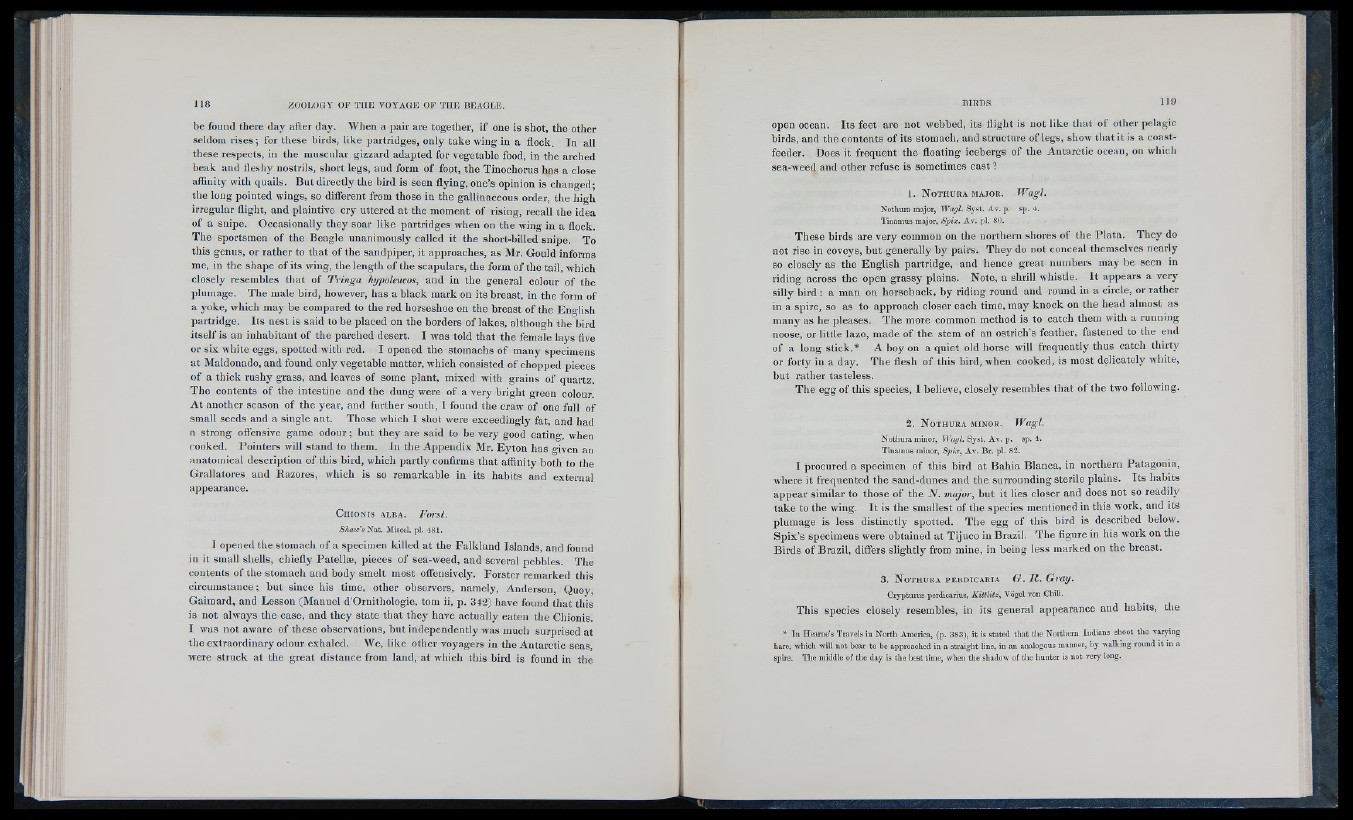
be found there day after day. When a pair are together, if one is shot, tlie other
seldom rises; for these birds, like partridges, only take wing in a flock. In all
these respects, in the muscular gizzard adapted for vegetable food, in the arched
beak and fleshy nostrils, short legs, and form of foot, the Tinochorus has a close
affinity with quails. But directly the bird is seen flying, one’s opinion is changed;
the long pointed wings, so different from those in the gallinaceous order, the high
irregular flight, and plaintive cry uttered at the moment of rising, recall the idea
of a snipe. Occasionally they soar like partridges when on the wing in a flock.
The sportsmen of the Beagle unanimously called it the short-billed snipe. To
this genus, or rather to that of the sandpiper, it approaches, as Mr. Gould informs
me, in the shape of its wing, the length of the scapulars, the form of the tail, which
closely resembles that of Tringa hypoleucos, and in the general colour of the
plumage. The male bird, however, has a black mark on its breast, in the form of
a yoke, which may be compared to the red horseshoe on the breast of the English
partridge. Its nest is said to be placed on the borders of lakes, although the bird
itself is an inhabitant of the parched desert. I was told that the female lays five
or six white eggs, spotted with red. I opened the stomachs of many specimens
at Maldonado, and found only vegetable matter, which consisted of chopped pieces
of a thick rnshy grass, and leaves of some plant, mixed with grains of quartz.
The contents of the intestine and the dung were of a very bright green colour.
At another season of the year, and further south, I found the craw of one full of
small seeds and a single ant. Those which I shot were exceedingly fat, and had
a strong offensive game odour; but they are said to be very good eating, when
cooked. Pointers will stand to them. In the Appendix Mr. Eyton has given an
anatomical description of this bird, which partly confirms that affinity both to the
Grallatores and Razores, which is so remarkable in its habits and external
appearance.
CmoNis A L B A . Forst.
Shaw’g'iiia.t. Misccl. pl. 481.
I opened the stomach of a specimen killed at the Falkland Islands, and found
in it small shells, chiefly Patellae, pieces of sea-weed, and several pebbles. The
contents of the stomach and body smelt most offensively. Forster remarked this
circumstance; but since his time, other observers, namely, Anderson, Quoy,
Gairaard, and Lesson (Manuel d’Ornithologie, tom ii, p. 342) have found that this
is not always the case, and they state that they have actually eaten the Chionis.
I was not aware of these observations, but independently was much surprised at
the extraordinary odour exhaled. We, like other voyagers in the Antarctic seas
were struck at the great distance from land, at which this bird is found in the
open ocean. Its feet are not webbed, its flight is not like that of other pelagic
birds, and the contents of its stomach, and structure of legs, show that it is a coast-
feeder. Does it frequent the floating icebergs of the Antarctic ocean, on which
sea-weed and other refuse is sometimes cast ?
1. N o THURA MAJOR. Wagl.
Notbura major, Wagl. Syst. Av. p. sp. 4.
Tiiiamus major, Spix. Av. pl. 80.
These birds are very common on the northern shores of the Plata. They do
not rise in coveys, but generally by pairs. They do not conceal themselves nearly
so closely as the English partridge, and hence great numbers may be seen in
riding across the open grassy plains. Note, a shrill whistle. It appears a very
silly bird : a man on horseback, by riding round and round in a circle, or rather
in a spire, so as to approach closer each time, may knock on the head almost as
many as he pleases. The more common method is to catch them with a running
noose, or little lazo, made of the stem of an ostrich’s feather, fastened to the end
of a long stick.* A boy on a quiet old horse will frequently thus catch thirty
or forty in a day. The flesh of this bird, when cooked, is most delicately white,
but rather tasteless.
The egg of this species, I believe, closely resembles that of the two following.
2 . N o t h u r a m in o r . Wagl.
Notbura minor, Wagl. Syst. Av. p. sp. 4.
Tinamus minor, Spix, Av. Br. pl. 82.
I procured a specimen of this bird at Bahia Blanca, in northern Patagonia,
where it frequented the sand-dunes and the surrounding sterile plains. Its habits
appear similar to those of the N. major, but it lies closer and does not so readily
take to the wing. It is the smallest of the species mentioned in this work, and its
plumage is less distinctly spotted. The egg of this bird is described below.
Spix’s specimens were obtained at Tijuco in Brazil. The figure in his work on the
Birds of Brazil, differs slightly from mine, in being less marked on the breast.
3 . N o t h u r a p e r d ig a r ía G. R . Gray.
Crypturus perdicarius, Kittlitz, Vögel von Chili.
This species closely resembles, in its general appearance and habits, the
* In Hearnc’s Travels in North America, (p. 383), it is stated that the Northern Indians shoot the varying
hare; which will not bear to be approached in a straight line, in an analogous manner, by walhmg round it m a
spire. The middle of the day is the best time, when the shadow of the hunter is not very long.